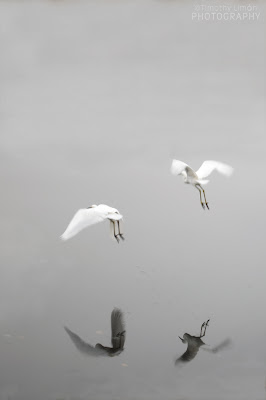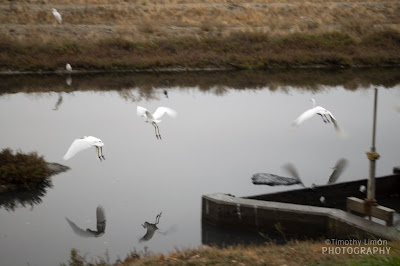
In this picture
we see two snow egrets flying low across the glassy water. The background is completely void of any distractions. Your eye is drawn to the subject and then down to the reflection. If I did my job right, you feel the serenity and quietness of the scene. Maybe you even feel a bit lonely.
Half the battle of being a photographer is knowing how to post process the image. This can be as simple as fixing a blemish on an otherwise perfect portrait, dodging (lightening) the subject to draw attention, or as drastic as compositing (combining multiple images) to create a something that never actually happened. It all depends on what you, the artist, are trying to convey.
If your goal is
to be as realistic as possible, as in photojournalism, then post processing has to be light. Maybe only adjusting the contrast, reducing the digital noise, or tweaking the brightness is all that's allowed.
For this image, I cropped vertical, and used Photoshop to clone out the background leaving only the two birds. The original image below shows quite a different scene. Shot by the side of the busy road, these two birds were not alone at all.
 When I first looked at the image, I almost threw it out. There was so much going on, and my low ISO/slow shutter speed made for some motion blur. But, in post, I was able to clean it up quite a bit.
When I first looked at the image, I almost threw it out. There was so much going on, and my low ISO/slow shutter speed made for some motion blur. But, in post, I was able to clean it up quite a bit.We, as photographers,
should always try to get it right in the camera, but sometimes things happen way too fast for us to think. These "grab shots" don't often turn out well, but, before you press that "delete button", ask yourself, could I fix this in Photoshop? Many times the answer is Yes!





No comments:
Post a Comment